Relationship between dental and periodontal health status and the salivary microbiome: bacterial diversity, co-occurrence networks and predictive models
- PMID: 33441710
- PMCID: PMC7806737
- DOI: 10.1038/s41598-020-79875-x
Relationship between dental and periodontal health status and the salivary microbiome: bacterial diversity, co-occurrence networks and predictive models
Abstract
The present study used 16S rRNA gene amplicon sequencing to assess the impact on salivary microbiome of different grades of dental and periodontal disease and the combination of both (hereinafter referred to as oral disease), in terms of bacterial diversity, co-occurrence network patterns and predictive models. Our scale of overall oral health was used to produce a convenience sample of 81 patients from 270 who were initially recruited. Saliva samples were collected from each participant. Sequencing was performed in Illumina MiSeq with 2 × 300 bp reads, while the raw reads were processed according to the Mothur pipeline. The statistical analysis of the 16S rDNA sequencing data at the species level was conducted using the phyloseq, DESeq2, Microbiome, SpiecEasi, igraph, MixOmics packages. The simultaneous presence of dental and periodontal pathology has a potentiating effect on the richness and diversity of the salivary microbiota. The structure of the bacterial community in oral health differs from that present in dental, periodontal or oral disease, especially in high grades. Supragingival dental parameters influence the microbiota's abundance more than subgingival periodontal parameters, with the former making a greater contribution to the impact that oral health has on the salivary microbiome. The possible keystone OTUs are different in the oral health and disease, and even these vary between dental and periodontal disease: half of them belongs to the core microbiome and are independent of the abundance parameters. The salivary microbiome, involving a considerable number of OTUs, shows an excellent discriminatory potential for distinguishing different grades of dental, periodontal or oral disease; considering the number of predictive OTUs, the best model is that which predicts the combined dental and periodontal status.
Conflict of interest statement
The authors declare no competing interests.
Figures
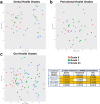

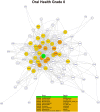
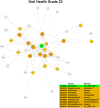
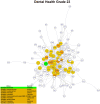
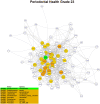
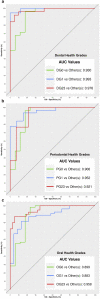
Similar articles
-
The Oral Microbiome in the Elderly With Dental Caries and Health.Front Cell Infect Microbiol. 2019 Jan 4;8:442. doi: 10.3389/fcimb.2018.00442. eCollection 2018. Front Cell Infect Microbiol. 2019. PMID: 30662876 Free PMC article.
-
Relative abundance of total subgingival plaque-specific bacteria in salivary microbiota reflects the overall periodontal condition in patients with periodontitis.PLoS One. 2017 Apr 3;12(4):e0174782. doi: 10.1371/journal.pone.0174782. eCollection 2017. PLoS One. 2017. PMID: 28369125 Free PMC article.
-
The salivary microbiome as a diagnostic biomarker of periodontitis: a 16S multi-batch study before and after the removal of batch effects.Front Cell Infect Microbiol. 2024 Jul 12;14:1405699. doi: 10.3389/fcimb.2024.1405699. eCollection 2024. Front Cell Infect Microbiol. 2024. PMID: 39071165 Free PMC article.
-
The oral microbiome and human health.J Oral Sci. 2017;59(2):201-206. doi: 10.2334/josnusd.16-0856. J Oral Sci. 2017. PMID: 28637979 Review.
-
Microbiome Sequencing Methods for Studying Human Diseases.Methods Mol Biol. 2018;1706:77-90. doi: 10.1007/978-1-4939-7471-9_5. Methods Mol Biol. 2018. PMID: 29423794 Review.
Cited by
-
The salivary microbiome shows a high prevalence of core bacterial members yet variability across human populations.NPJ Biofilms Microbiomes. 2022 Oct 20;8(1):85. doi: 10.1038/s41522-022-00343-7. NPJ Biofilms Microbiomes. 2022. PMID: 36266278 Free PMC article.
-
Analysis of Salivary Levels of IL-1β, IL17A, OPG and RANK-L in Periodontitis Using the 2017 Classification of Periodontal Diseases-An Exploratory Observational Study.J Clin Med. 2023 Jan 28;12(3):1003. doi: 10.3390/jcm12031003. J Clin Med. 2023. PMID: 36769650 Free PMC article.
-
Ex-vivo investigation of human salivary microbial growth with lysogeny broth for translational research-A pilot study.J Dent Sci. 2025 Jan;20(1):437-443. doi: 10.1016/j.jds.2024.05.014. Epub 2024 Jun 1. J Dent Sci. 2025. PMID: 39873074 Free PMC article.
-
Study on characteristics of gut flora composition of pregnant women with preeclampsia.BMC Pregnancy Childbirth. 2025 May 31;25(1):636. doi: 10.1186/s12884-025-07760-4. BMC Pregnancy Childbirth. 2025. PMID: 40450263 Free PMC article.
-
No evidence for a common blood microbiome based on a population study of 9,770 healthy humans.Nat Microbiol. 2023 May;8(5):973-985. doi: 10.1038/s41564-023-01350-w. Epub 2023 Mar 30. Nat Microbiol. 2023. PMID: 36997797 Free PMC article.
References
-
- Kassebaum NJ, et al. Global, regional, and national prevalence, incidence, and disability-adjusted life years for oral conditions for 195 countries, 1990–2015: A systematic analysis for the global burden of diseases, injuries, and risk factors. J. Dent. Res. 2017;96:380–387. doi: 10.1177/0022034517693566. - DOI - PMC - PubMed
Publication types
MeSH terms
Substances
LinkOut - more resources
Full Text Sources
Other Literature Sources
Medical

